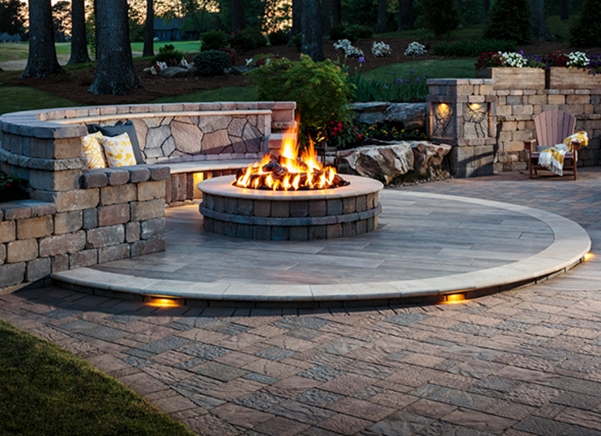TIP #1: Shed some light.
Lighting design is a crucial element of any outdoor kitchen. You want enough lighting to be able to see what you’re doing without spoiling the ambiance. To give your outdoor kitchen the feel of an indoor kitchen, think pendants. Low-voltage hardscape lighting attached to masonry walls will add delicate textural light. Lighting inside of cabinets and near cooking surfaces will help with functionality. String lights can add a festive touch and can be put on a circuit that’s controlled by a switch. Commercial grade string lights are often dimmable, so keep that in mind. Rule of thumb: plan all lighting before installing your kitchen so you can run all of the wiring, outlets and switches on the front end instead of having to retrofit. It’s always a good idea to include some overhead outlets in your plan, just in case you want to add string lights seasonally.
TIP #2: Think long-term.
The primary thing to remember about an outdoor kitchen is that everything is exposed to the elements. Be sure to choose durable building materials and outdoor-rated products that are designed to take the abuse. Yes, sometimes that means spending a little extra money on the front end, but the money will go further in the long run when everything lasts longer. It’s also wise to protect your investment by sealing porous surfaces and purchasing covers for exposed appliances.
TIP #3: Sometimes bigger is better, but read the fine print.
Think about how you plan to use the space and plan accordingly. Bar-sized sinks save counter space and will do the trick for washing your hands or rinsing a glass. But if you plan to actually rinse a platter or fill a pitcher, you’d do better to install a standard kitchen sink. When purchasing appliances like grills, refrigerators and ice-makers, read the specs carefully. The dimensions don’t always equate to cubic feet of usable space. Also, you’ll often go through ice quickly, so make sure the unit you buy can keep up with your production needs. If you plan to entertain often, roll-top beverage coolers hold significantly more cans and bottles than a standard counter-height refrigerator. That’s exactly why restaurants and bars use them.
TIP #4: You’ll want more space than you think.
At the the end of the day, you’ll likely wish you had more prep space, more outdoor seating space, more storage space or more cooking space. It’s often hard to conceptualize the finished space in the planning phase. However, if you’re working with a Belgard Authorized Contractor, you can get free virtual reality designs. When you put on the VR goggles, you can immerse yourself in the design and look up, down and all around to make sure you will have all the space you need.
TIP #5: Plan ahead.
First of all, you can never have enough outlets. Someone always wants to plug in something — a blender, a lamp, a charger, a laptop, a streaming device. Some of those outlets should include usb ports, too. Also think about what you might want to add to your kitchen down the line. Even if you don’t plan to use any gas now, it’s not a bad idea to plumb a natural gas line, even if you just cap it for now. You never know when you might want to add a fire feature, outdoor heater or a high intensity burner. Constantly changing out butane tanks is a pain, and retrofitting for natural gas later can be a costly endeavor.
For inspiration and kitchen design ideas, visit the Belgard Outdoor Kitchen Pinterest Board.


